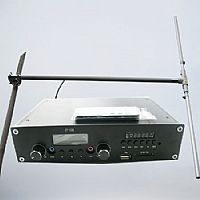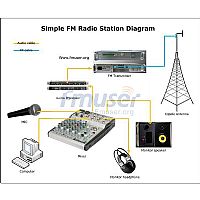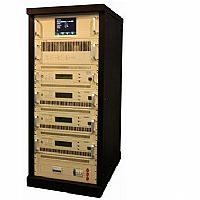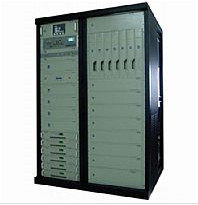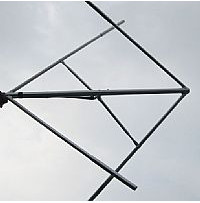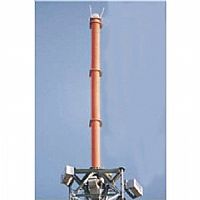High Frequency PCB Design: Factors Affecting RF Signal Performance
With the rise of the Internet of Things technology, it is becoming more and more common for electronic products to carry wireless communication functions, and wireless communication technology relies on the RF circuit on the PCB to achieve. Unfortunately, even PCB designers, for RF Circuits are also often prohibitive, because it brings huge design challenges and requires professional design and simulation analysis tools. Because of this, for many years, the RF part of the PCB has been designed by independent designers with RF design expertise.
The RF circuit design engineer has moved out of 18 martial arts, after a fierce operation, designed the RF circuit layout below, and exported the DXF format to the PCB Layout for copying. Isn’t it cool?
After PCB design Siege Lion imported the RF circuit DXF format file, it found that the trace has both right angles and sharp corners. I thought to myself, emmm, this radio frequency is real water, and the salary is higher than labor and capital, so it is not necessary to avoid sharp chamfering and arc transition. Understand, then re-optimized the routing of the RF circuit part
result…
In order to avoid misunderstandings in the future, the radio frequency bacteria called out the layout bacteria after get off work, closed the door and the handle to guide some related points of radio frequency PCB design.
According to radio frequency circuit theory, when the wavelength of the signal transmitted on the signal connection line can be compared with the geometric size of the discrete circuit element, the pad of the radio frequency IC pin, the transmission line of the radio frequency signal on the PCB, the radio frequency passive device, Vias and even grounded copper are important factors that seriously affect the performance of RF signals.
Microstrip line is an ideal choice for high frequency signal transmission on PCB. Unless the connection distance between IC and antenna is very short, please use coaxial cable or transmission line with matching characteristic impedance. On the printed circuit board, it is best to use a microstrip transmission line with the structure shown in the figure below.
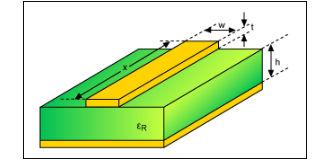
The microstrip transmission line includes a fixed-width metal trace (conductor) and a ground area directly below (adjacent layer). For example, traces on layer 1 (top metal) require a solid ground area on layer 2. The width of the trace, the thickness of the dielectric layer, and the type of dielectric determine the characteristic impedance (usually 50Ω or 75Ω).
Of course, in addition to the microstrip line, there is also a common transmission line is the strip line, as shown in the figure below

The stripline includes fixed-width traces on the inner layer, and grounding areas above and below it. The conductor can be located in the middle of the ground area or have a certain offset. This method is suitable for the inner radio frequency routing.
Since stripline is also suitable for RF routing, why does Lao Wu say that microstrip line is an ideal choice for high frequency signal transmission on PCB?
Whether it is a microstrip line or a stripline, both have excellent performance in transmitting millimeter wave frequencies, and the difference lies in the manufacturing cost.
Compared with stripline circuits, microstrip circuits have fewer processing steps, and circuit components are easier to place, and therefore easier to manufacture (lower manufacturing costs). Compared with microstrip lines, strip lines can provide more isolation for adjacent circuit lines and support a denser component layout. In addition, stripline circuits are also very suitable for manufacturing multilayer circuit boards, and each layer can be well isolated.
The electrical properties of microstrip and stripline conductors are affected by the dielectric constant of the insulating material and the proximity effect of the ground layer. The microstrip line has only one ground plane, while the stripline has two ground planes. For a microstrip line, the effective dielectric constant that affects the impedance of the conductor is the sum of the relative dielectric constant of the insulating material and the air above the circuit (equal to 1). The effective dielectric constant of the strip line is the sum of the relative dielectric constants of the upper and lower substrates of the conductor.
As with all high-frequency circuits, keeping impedance under control is critical to achieving consistent amplitude and phase response electrical performance. The impedance of the conductors of the two transmission lines is, among other factors, a function of the width of the conductor, the thickness of the conductor, the thickness of the insulating substrate, and the relative permittivity or dielectric constant of the substrate. For strip lines, it does not matter whether the distance between the center conductor and the two ground planes is equal, or whether the dielectric constants of the insulators above and below the conductor are the same (the same is true for microstrip lines).
The stripline has two ground planes, so the 50Ω (or any given impedance) line of the stripline is thinner than the conductor of the same impedance of the microstrip line. Although thinner wires support greater circuit density, thinner wires also require tighter manufacturing tolerances, and the dielectric constant of the entire circuit substrate must be very consistent. The dielectric loss of the single-ended (unbalanced) transmission line of the microstrip line (defined by the dissipation factor of the substrate) is less than that of the strip line. This is because some field lines of the microstrip line are in the air, and the dissipation factor can be can be ignored.
Of course, the performance of these two transmission lines is actually almost the same as the performance of the carrier used in their manufacture-the insulating substrate. Just as the PCB materials used, such as FR-4, can reduce costs, but at the same time limit its performance. According to different microstrip lines and strip line applications, choosing the most suitable material will better play the role of these two transmission lines. advantage.
As with many engineering decisions, the choice of microstrip or stripline will be weighed. For example, stripline circuits have a high circuit density. Therefore, under the same frequency conditions, they require more material layers, more processing time and expense, and more attention to detail processing than microstrip circuits.
Compared with common microstrip lines and strip lines, there is another type of radio frequency transmission line that is grounded coplanar waveguide, which provides better isolation between adjacent radio frequency lines and other signal lines. This medium includes the middle conductor and the grounding area on both sides and below as shown below:
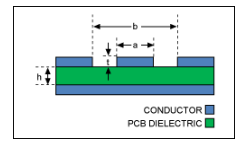
It is recommended to install via "fences" on both sides of the grounded coplanar waveguide, as shown in the figure below. This top view provides an example of installing a row of ground vias in the top metal ground area on each side of the intermediate conductor. The loop current caused on the top layer is shorted to the ground plane below.
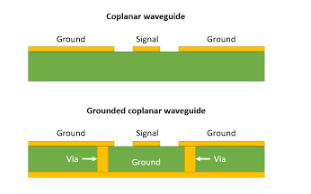
Compared with the microstrip line, the grounded coplanar waveguide not only has a ground plane on the bottom surface of the medium, but also has ground planes on both sides of the signal transmission line on the top of the medium, so it has a larger ground area. The coplanar waveguide achieves the stability of electrical performance by using the ground plane to surround the signal line.
The transmission modes of the microstrip line and the grounded coplanar waveguide circuit are both quasi-transverse electromagnetic modes (quasi-TEM). Due to the enhanced grounding structure of the grounded coplanar waveguide circuit, its machining is more complicated to a certain extent. Compared with the microstrip line, the grounded coplanar waveguide circuit has the characteristics of low dispersion. When the frequency rises to the millimeter wave band, the grounded coplanar waveguide circuit has lower radiation loss than the microstrip line circuit.
Due to the enhanced grounding structure, the grounded coplanar waveguide circuit has a wider effective bandwidth and a larger impedance range than the microstrip circuit. However, the microstrip circuit structure is relatively robust, and its simple bottom ground circuit structure is easy to process. In addition, the performance of the microstrip circuit is not sensitive to circuit processing factors, and its circuit performance is less affected by the difference in conductor/gap etching and the difference in conductor thickness.
The sharp bends in the RF circuit layout are specially designed for transmission line bend compensation.
When the transmission line is required to bend (change the direction) due to wiring constraints, the bending radius used should be at least 3 times the width of the intermediate conductor. In other words:
Bending radius ≥ 3 × (line width).
This minimizes the characteristic impedance change of the corner.
If it is impossible to achieve gradual bending, the transmission line can be bent at right angles (non-curved), as shown in the figure below. However, this must be compensated to reduce the sudden change in impedance caused by the increase in the local effective line width when passing through the bending point.

Our other product:






